Biological Control Of Common Pests and Diseases Affecting Banana Plants
- Biological Control
-
- Commodity name: Biological Control Of Common Pests and Diseases Affecting Banana Plants
Bananas are a vital crop for many farmers, but they are vulnerable to a range of pests and diseases that can greatly affect yield and quality. Common pests such as banana weevils, thrips, and nematodes can damage the roots, stems, and fruit, hindering the plant’s growth and fruit production. Additionally, diseases like Panama disease, Black Sigatoka, and Banana Bunchy Top Virus pose serious threats to the health of banana plants, leading to symptoms like wilting, leaf spotting, and reduced fruit quality. Identifying, monitoring, and managing these issues are essential steps in maintaining a healthy banana crop. In this article, we will explore the various pests and diseases that affect banana plants. Continue reading to learn more.
Banana Pests
Banana Plant diseases
Banana Nutrition
Banana Pests
1. Banana Weevil (Cosmopolites sordidus)
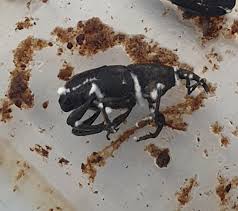
Features:
Banana weevils (Cosmopolites sordidus) are small, dark-colored beetles with a distinctive snout, known for their burrowing behavior in banana plants. Adult weevils are typically about 10-12 mm long, with a hard, shiny exoskeleton. They are often found near the base of banana plants, especially in moist environments.
Symptoms:
Infestation by banana weevils can lead to significant damage in banana plants. The weevils bore into the corms and pseudostems, causing extensive tunneling. This feeding activity weakens the plant, leading to reduced vigor, stunted growth, and increased susceptibility to diseases. Severe infestations can result in plant toppling, particularly during heavy winds.
Management:
Managing banana weevils involves a combination of cultural, biological, and chemical methods. Cultural practices include crop rotation and the removal of plant debris to reduce weevil breeding sites. Introducing natural predators or parasites, such as entomopathogenic fungi, can help control weevil populations biologically. Chemical control through the use of targeted insecticides may be necessary in severe cases, but these should be used judiciously to minimize environmental impact and avoid resistance development. Regular monitoring and early intervention are crucial in preventing significant damage from banana weevils.
Solution:
A biological solution for managing Banana Weevils in banana plants involves using natural, fungus-based products like MET Zone. This granular insecticide contains Metarhizium anisopliae, a fungus that acts as a natural pathogen to the Banana Weevil. By applying MET Zone directly to the soil around the banana plants, the fungus infects and eliminates the weevils without harming the plants or other beneficial insects. This method provides an effective, eco-friendly way to protect banana crops from this pest.
2. Nematodes (Radopholus similis)
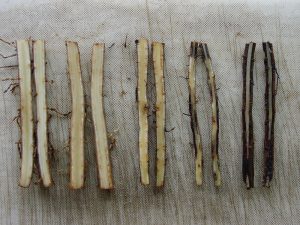 Features:
Features:Nematodes are microscopic roundworms that can be detrimental to banana plants. The most harmful nematode species affecting bananas include the burrowing nematode (Radopholus similis) and the root-knot nematode (Meloidogyne spp.). These pests are invisible to the naked eye and primarily infest the root system of banana plants.
Symptoms:
Infestation by nematodes leads to several symptoms in banana plants, such as root damage, which manifests as root lesions, necrosis, and galls (in the case of root-knot nematodes). This damage disrupts the plant’s ability to absorb water and nutrients, resulting in stunted growth, yellowing of leaves, and reduced fruit yield. In severe cases, the plant may exhibit wilting and dieback.
Management:
Managing nematodes in banana cultivation involves several strategies. Crop rotation with non-host crops can reduce nematode populations in the soil. Organic amendments, such as compost and manure, can improve soil health and reduce nematode damage. The use of resistant banana cultivars is also an effective approach. Chemical nematicides can be used, but they should be applied carefully, considering environmental and health safety. Additionally, soil solarization and biofumigation techniques can help reduce nematode populations before planting. Regular monitoring and soil testing are essential for early detection and effective management of nematode infestations.
Solution:
For managing nematodes in banana plants, a biological solution using products like MET Zone Nema Promax or Nema Pro from Novobac is recommended. These products contain beneficial nematodes that target and control harmful nematode pests. By applying these products to the soil around banana plants, the beneficial nematodes can effectively reduce the population of harmful nematodes, protecting the banana roots and improving plant health. This method is safe for the plants and the environment, providing a natural way to manage nematode infestations.
3. Banana Aphids (Pentalonia nigronervosa)
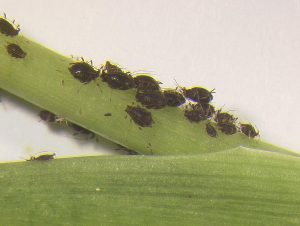
Features:
Aphids are small, soft-bodied insects that can be green, yellow, black, or brown. They often appear in clusters on the undersides of leaves, stems, and young banana plant shoots. These pests are easily identifiable by their pear-shaped bodies and the two small, tube-like structures called cornicles protruding from their rear.
Symptoms:
Aphids damage banana plants by sucking sap from leaves and tender shoots, which can lead to yellowing, curling, and wilting of leaves. Heavy infestations can result in stunted growth and reduced vigor. Aphids also excrete a sticky substance called honeydew, which can promote the growth of sooty mold fungi, further inhibiting photosynthesis and overall plant health. Additionally, aphids are known vectors of plant viruses, which can cause further harm to banana crops.
Management:
Effective management of aphids in banana plants includes promoting natural predators such as ladybugs, lacewings, and parasitic wasps that feed on aphids. Introducing these beneficial insects can significantly reduce aphid populations. Insecticidal soaps or oils can also be used to control aphids, particularly in cases of severe infestations. These should be applied with caution to minimize harm to beneficial insects. Maintaining good field hygiene, such as removing infested plant material and controlling weeds, can also help manage aphid populations and reduce the risk of virus transmission. Regular monitoring is essential to detect early signs of infestation and implement timely control measures.
Solution:
A biological approach to managing aphids in banana plants involves using natural, fungus-based solutions. Products like Beveria WP from Novobac are effective for controlling these pests. This fungus acts as a natural pathogen, infecting and eliminating aphids without harming the banana plants or beneficial insects. By applying Beveria WP directly to the affected areas or the surrounding soil, you can significantly reduce aphid populations and protect your banana crops.
4. Banana Borer (Odoiporus longicollis)
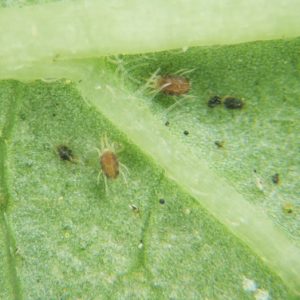
Features:
Banana borers (Odoiporus longicollis) are a type of beetle that specifically targets banana plants. They are medium-sized, about 2-3 cm in length, with a cylindrical body and a characteristic elongated snout. The adults are typically black or dark brown and are known for laying eggs in the pseudostem of banana plants.
Symptoms:
The presence of banana borers is often indicated by the appearance of small, pin-sized holes on the pseudostem of banana plants, which are entry points created by adult females for laying eggs. The larvae hatch and bore into the plant tissues, creating extensive galleries that disrupt the flow of nutrients and water. This tunneling causes wilting, yellowing of leaves, and can lead to the collapse of the pseudostem. In severe cases, the plant may topple over or fail to produce fruit.
Management:
Effective management of banana borers involves an integrated approach. Cultural practices such as maintaining field hygiene by removing plant debris and infested plants can reduce breeding sites. Biological control methods include using natural predators or parasites, such as parasitoid wasps, that target the borers. Chemical control may be employed using insecticides, but these should be carefully selected and applied to avoid harming non-target organisms. Regular monitoring and early detection of borer activity are crucial for timely intervention and to prevent significant damage to banana crops.
Solution:
A biological approach to managing Banana Borers in banana plants involves using natural, fungus-based solutions. Products like Beaveria WP, which contains the fungus Beauveria bassiana, are effective in controlling these pests. Beauveria bassiana acts as a natural pathogen, infecting and killing Banana Borers without harming the banana plants or beneficial insects. Applying this product directly to affected areas or the surrounding soil can significantly reduce Banana Borer populations and protect your banana plants. Novobac offers these solutions, providing a safe and eco-friendly way to manage pests in banana cultivation.
5. Thrips (Chaetanaphothrips signipennis)
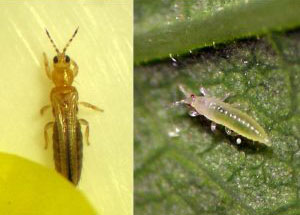
Features:
Thrips are tiny, slender insects with fringed wings, typically measuring around 1-2 mm in length. They can be yellow, brown, or black and are often found in large numbers. Thrips have piercing-sucking mouthparts, which they use to feed on plant tissues, including leaves, flowers, and fruit. They are commonly seen on banana plants, especially in warmer climates.
Symptoms:
Thrips damage banana plants by feeding on the sap, which leads to silvery or bronzed discoloration on the leaves, commonly referred to as “silvering.” Affected leaves may also display small, dark fecal spots. Severe infestations can cause leaf curling, scarring on the fruit, and reduced plant vigor. Thrips feeding can also result in deformed fruits and flowers, impacting yield and quality.
Management:
Effective management of thrips in banana plants involves a combination of cultural, biological, and chemical control strategies. Cultural practices include removing and destroying infested plant material and maintaining good field hygiene to reduce thrips breeding sites. Biological control can be achieved by encouraging natural predators such as predatory mites and lacewings. Chemical control may involve the use of insecticides, but these should be applied judiciously and in rotation to prevent resistance development. Monitoring thrips populations regularly and implementing integrated pest management (IPM) strategies can help keep infestations under control and minimize damage to the banana crop.
Solution:
Thrips are a common pest affecting banana plants, causing damage to leaves and fruit. A biological approach to managing thrips involves using natural, fungus-based solutions. One effective product is Beaveria WP from Novobac, which contains the fungus Beauveria bassiana. This fungus acts as a natural pathogen, infecting and killing thrips without harming the banana plants or beneficial insects. Applying Beaveria WP directly to affected areas or the surrounding soil can significantly reduce thrips populations, helping to protect your banana plants.
6. Spider Mites (Tetranychus urticae)
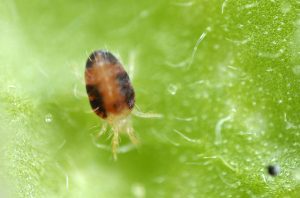
Features:
Spider mites are tiny, spider-like arachnids that often appear as small red, green, or yellow spots on the underside of banana leaves. They are extremely small, usually less than 1 mm in size, and are often detected by the fine webbing they produce. These mites thrive in hot, dry conditions and can multiply rapidly, leading to large infestations.
Symptoms:
Infestations of spider mites on banana plants cause several symptoms, including yellowing or bronzing of leaves, a stippled appearance due to the sucking of plant sap, and reduced photosynthesis. Severe infestations can lead to premature leaf drop, weakened plants, and reduced fruit yield. The presence of fine webbing on leaves is a characteristic sign of spider mite activity.
Management:
Effective management of spider mites in banana crops includes a combination of cultural, biological, and chemical controls. Culturally, maintaining adequate irrigation and humidity levels can help deter mite populations, as they thrive in dry conditions. Introducing natural predators such as predatory mites or ladybugs can provide biological control. Chemical control should be used as a last resort, with careful selection of miticides that are effective against spider mites but less harmful to beneficial insects. Regular monitoring for early detection and implementing integrated pest management strategies can help keep spider mite populations under control and prevent significant crop damage.
Solution:
To manage Spider Mites on banana plants, a biological approach using natural, fungus-based solutions is effective. Products like Beaveria WP and Metarhizium anisopliae, produced by Novobac, work well for controlling these pests. These fungi act as natural pathogens, targeting and eliminating Spider Mites without harming the banana plants or beneficial insects. Applying these products directly to the infested areas or the surrounding soil can significantly reduce Spider Mite populations, helping to protect your banana plants.
7. Fruit Fly (Bactrocera spp.)
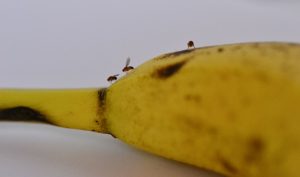
Features:
Fruit flies, particularly the species Bactrocera spp., are small, colorful insects with distinctive markings on their wings. These pests are attracted to ripe or fermenting fruits, where they lay their eggs. The adult flies are usually around 5-7 mm in length and are characterized by their rapid and erratic flight patterns.
Symptoms:
Fruit fly infestations in bananas are primarily recognized by the presence of small puncture marks on the fruit’s skin, where the female lays her eggs. As the larvae (maggots) develop, they feed on the fruit’s flesh, causing internal decay and softening. This can lead to premature ripening, off-flavors, and significant post-harvest losses. Infested fruits often become unsalable due to the internal damage and unappealing appearance.
Management:
Managing fruit flies in banana cultivation involves integrated pest management strategies. Cultural practices include timely harvesting and proper disposal of overripe or damaged fruits to minimize breeding sites. Bagging bananas with protective covers can also prevent egg-laying. Biological control agents, such as parasitic wasps, can be introduced to naturally reduce fruit fly populations. Insecticide applications may be considered, but they should be used selectively and in conjunction with other control methods to reduce resistance and environmental impact. Regular monitoring and the use of pheromone traps can aid in early detection and control of fruit fly infestations.
Solution:
To effectively manage fruit fly infestations in banana plants, a biological approach using natural fungus-based solutions can be highly effective. Products like Beauveria bassiana or Metarhizium anisopliae, available from Novobac, act as natural pathogens. These fungi infect and kill fruit flies without harming the banana plants or beneficial insects. Applying these products directly to the affected areas or the surrounding soil can significantly reduce fruit fly populations, protecting your banana plants and promoting a healthy ecosystem.
8. Mealybugs (Dysmicoccus brevipes)
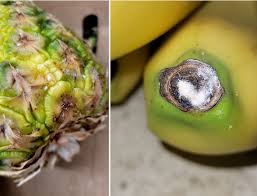
Features:
Mealybugs are small, soft-bodied insects covered with a white, powdery or waxy coating. These pests are known for their distinctive appearance, resembling small cotton tufts on banana plants. Mealybugs are often found in clusters on the undersides of leaves, at the base of leaf sheaths, or in other protected areas of the plant. They are slow-moving and can be easily recognized by their segmented bodies and short antennae.
Symptoms:
Mealybug infestations in banana plants can cause a range of symptoms. These insects feed on plant sap, leading to the yellowing and wilting of leaves. Their feeding activity also results in the production of honeydew, a sticky substance that can lead to the growth of sooty mold on plant surfaces, further reducing photosynthetic efficiency. Severe infestations can weaken the plants, stunting growth and reducing fruit yield and quality. Mealybugs can also transmit plant viruses, compounding the damage.
Management:
Controlling mealybugs involves a combination of cultural, biological, and chemical approaches. Cultural methods include removing infested plant parts and maintaining good plant hygiene to reduce infestation sources. Biological control can be achieved by introducing natural predators, such as ladybugs and lacewings, which feed on mealybugs. For chemical control, insecticidal soaps and oils can be effective, especially when applied directly to the pests. In more severe cases, systemic insecticides may be necessary, but these should be used carefully to minimize harm to beneficial insects. Regular monitoring and early treatment are essential to prevent mealybug populations from reaching damaging levels.
Solution:
For managing Mealybugs, a common pest in banana cultivation, a biological approach using fungus-based solutions like Beveria WP from Novobac is effective. Beveria WP contains a naturally occurring fungus that acts as a pathogen to Mealybugs, infecting and eliminating them without harming the banana plants or beneficial insects. By applying Beveria WP directly to the affected areas or the surrounding soil, you can significantly reduce Mealybug populations and protect your banana crop.
9. Scales (Aspidiotus destructor)
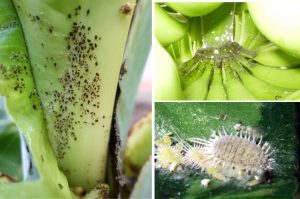
Features:
Scale insects are small, oval-shaped pests that attach themselves to the surface of banana plant parts, including leaves, stems, and fruit. They are typically covered with a protective waxy or hard shell, which can be white, brown, or black. These pests are often found in clusters and can vary in size depending on the species. They feed by sucking sap from the plant, weakening it over time.
Symptoms:
Infestations of scale insects on banana plants can lead to several symptoms. These include yellowing leaves, reduced plant vigor, and stunted growth due to the loss of sap. The honeydew produced by scales can also promote the growth of sooty mold, which further reduces the plant’s ability to photosynthesize. In severe cases, scales can cause leaf drop and reduce fruit quality.
Management:
Controlling scale infestations involves an integrated approach. Introducing natural enemies such as ladybugs, parasitic wasps, and predatory beetles can effectively reduce scale populations. Regularly monitoring plants for early signs of scales and physically removing them can help manage smaller infestations. In more severe cases, horticultural oils or insecticidal soaps can be applied to smother the scales, but these treatments should be used carefully to avoid harming beneficial insects. Ensuring proper plant health and nutrition can also help plants resist and recover from scale infestations.
Solution:
To manage Scales, a common pest in banana plants, a biological approach can be used. Using products like Beauveria bassiana or Metarhizium anisopliae, such as those offered by Novobac, is effective. These fungi act as natural pathogens, infecting and eliminating Scales without harming the banana plants or beneficial insects. Applying these fungal products directly to the affected areas or the surrounding soil can help reduce Scale populations and protect your banana crop.
10. Whiteflies (Bemisia tabaci)
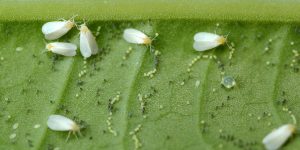
Features:
Whiteflies are small, sap-sucking insects that are commonly found on the underside of banana leaves. They are named for the white, powdery wax covering their wings and bodies. Adult whiteflies are about 1-2 mm in length and can be seen flying in small clouds when disturbed. These pests are especially prevalent in warm, humid climates and can rapidly reproduce under favorable conditions.
Symptoms:
Whiteflies damage banana plants by feeding on the plant’s sap, which can lead to yellowing, wilting, and reduced vigor of the leaves. The excretion of honeydew by whiteflies promotes the growth of sooty mold, a black fungus that can cover leaves and hinder photosynthesis. This can further weaken the plant and reduce fruit yield. Whiteflies are also vectors for several plant viruses, which can cause additional diseases in banana crops.
Management:
Effective management of whiteflies in banana plantations involves integrated pest management strategies. Regular monitoring is essential for early detection and to assess infestation levels. Biological control measures include the introduction of natural predators such as ladybugs, lacewings, and parasitic wasps. Sticky traps can also be used to capture adult whiteflies. In cases of severe infestation, selective insecticides may be applied, but care should be taken to minimize harm to beneficial insects and prevent the development of resistance. Maintaining plant health through proper nutrition and avoiding overcrowding can also reduce the susceptibility of banana plants to whitefly infestations.
Solution:
A biological approach to managing whiteflies in banana plants involves using natural, fungus-based solutions. Products like Beaveria WP, produced by Novobac, are effective in controlling these pests. This fungus acts as a natural pathogen, infecting and eliminating whiteflies without harming banana plants or beneficial insects. Applying Beaveria WP directly to the affected areas or the surrounding soil can significantly reduce whitefly populations and protect your banana crop.
11. Leafhoppers (Cicadellidae)
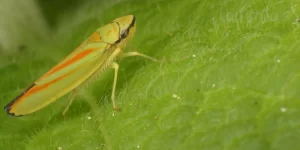
Features:
Leafhoppers are small, wedge-shaped insects, typically measuring 3-5 mm in length. They are known for their vibrant colors, which can include shades of green, yellow, or brown, and their distinctive jumping behavior. These insects are agile and can quickly move between plants. Leafhoppers are often found on the undersides of banana leaves, where they feed on the plant’s sap.
Symptoms:
Leafhoppers can cause considerable damage to banana plants through their feeding activity. They use their needle-like mouthparts to pierce the leaf tissues and extract sap, leading to symptoms such as yellowing, stippling, or bronzing of the leaves. This sap loss can weaken the plants and reduce photosynthetic capacity, potentially leading to reduced fruit yield. Additionally, leafhoppers can transmit plant pathogens, such as viruses and phytoplasmas, which can cause further harm to the plant.
Management:
Effective management of leafhoppers in banana crops includes a combination of cultural, biological, and chemical controls. Cultural practices like maintaining plant health through proper fertilization and irrigation can reduce the attractiveness of plants to leafhoppers. Introducing natural predators, such as lady beetles and lacewings, can help keep leafhopper populations in check. In cases of severe infestations, targeted insecticides may be necessary; however, they should be applied with caution to minimize impact on non-target species and prevent resistance development. Regular monitoring and early intervention are crucial for preventing leafhopper-induced damage and ensuring the health of banana plants.
Solution:
A biological approach to managing Leafhoppers in banana plants involves using natural, fungus-based solutions. Products like Bt Thuricide and Beauveria bassiana, available from Novobac, are effective for controlling these pests. Bt Thuricide is a bacterial insecticide that targets the digestive system of Leafhoppers, while Beauveria bassiana is a fungus that acts as a natural pathogen, infecting and killing the pests. These products can be applied directly to the affected areas or the surrounding soil, helping to reduce Leafhopper populations and protect banana plants without harming beneficial insects.
12. Banana Rust Thrips (Chaetanaphothrips orchidii)
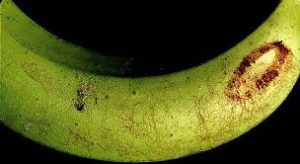
Features:
Banana rust thrips (Chaetanaphothrips signipennis) are tiny, slender insects with fringed wings, typically measuring about 1-2 mm in length. They are often yellowish or brownish in color. These pests are commonly found on banana plants, especially in the nooks and crannies of the banana bunches and on the leaves.
Symptoms:
Infestation by banana rust thrips can cause significant cosmetic damage to banana fruits, leading to a condition known as “rusting.” This appears as reddish-brown to black streaks or spots on the surface of the banana peel. While the internal fruit quality is not affected, the external blemishes can reduce marketability. Additionally, thrips feeding can cause silvering or scarring on the leaves, which may reduce photosynthetic efficiency and overall plant health.
Management:
Controlling banana rust thrips involves a combination of monitoring, cultural, and chemical methods. Regular inspection of banana plants, especially during the early stages of fruit development, helps in early detection. Cultural practices such as removing plant debris and maintaining good field hygiene can reduce thrips populations. For chemical control, targeted insecticides may be used, particularly during the early stages of fruit formation. However, it’s important to rotate insecticides with different modes of action to prevent resistance buildup. Biological control agents, like predatory mites or insects, can also be introduced to naturally manage thrips populations.
Solution:
For managing Banana Rust Thrips, a common pest affecting banana crops, a biological approach using a product like Beaveria WP from Novobac is effective. This product contains a natural fungus that acts as a pathogen to the thrips, infecting and eliminating them without harming the banana plants or beneficial insects. Applying Beaveria WP directly to the affected areas or surrounding soil can help reduce thrip populations and protect your banana plants.
13. Grasshoppers (Acrididae)
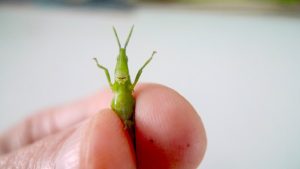
Features:
Grasshoppers are medium to large-sized insects characterized by their long hind legs adapted for jumping, wings, and often vibrant coloration. They are commonly green or brown, which helps them blend in with their surroundings. Grasshoppers are generalist feeders and can be found in various habitats, including fields and gardens, where they feed on a wide range of plant species, including bananas.
Symptoms:
Grasshoppers can cause notable damage to banana plants by feeding on the leaves and sometimes even the fruit. Their feeding creates irregular holes and tattered edges on the leaves, which can reduce the photosynthetic ability of the plant and lead to stunted growth. In severe infestations, they may consume entire leaves, causing significant defoliation and weakening the plant.
Management:
Managing grasshopper populations in banana plantations involves integrated pest management strategies. Cultural practices such as maintaining clean fields, removing weeds, and using trap crops can help reduce grasshopper numbers. Biological control measures include introducing natural predators like birds or beneficial insects that feed on grasshoppers. In cases of heavy infestations, insecticides may be used, but care should be taken to select products that are effective against grasshoppers while minimizing harm to other beneficial organisms. Regular monitoring of grasshopper activity is essential for early intervention and effective management.
Solution:
To manage Grasshoppers in banana plants, a biological approach can be highly effective. One such solution involves using the fungus-based product Metarhizium anisopliae, available from NovoBac. This natural pathogen infects and kills Grasshoppers without harming the banana plants or beneficial insects. Applying Metarhizium anisopliae directly to the affected areas or soil can significantly reduce Grasshopper populations and protect your banana crops.
14. Banana Skipper (Erionota thrax)
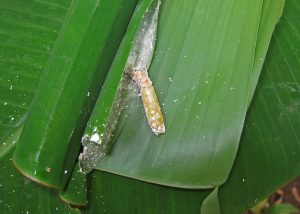
Features:
The banana skipper (Erionota thrax) is a moth whose larvae are known as banana leaf rollers. The adult moth has a wingspan of approximately 60-75 mm, with dark brown wings featuring distinctive white spots. The larvae are bright green with a black head and are often found within rolled-up banana leaves, which they create by folding and securing the leaves with silk.
Symptoms:
Banana skippers primarily damage banana plants through their larvae, which feed on the leaves. This feeding behavior leads to characteristic leaf rolling, where the edges of the leaves are curled inward. The damage can reduce the photosynthetic capacity of the plant, leading to slower growth and reduced fruit yield. In severe infestations, significant leaf area can be destroyed, affecting the overall health and productivity of the banana plant.
Management:
Managing banana skippers involves a mix of cultural, biological, and chemical control strategies. Culturally, removing and destroying rolled leaves can help reduce the population of larvae. Biological control can be achieved by introducing natural predators or parasitoids, such as Trichogramma wasps, which target the eggs of banana skippers. In cases of severe infestations, chemical control using specific insecticides may be necessary, though care should be taken to minimize impact on non-target organisms and the environment. Regular monitoring and prompt action are key to preventing extensive damage from banana skippers.
Solution:
For managing Banana Skipper pests in banana plants, a biological solution using Bt Thuricide, a product from Novobac, is effective. Bt Thuricide contains Bacillus thuringiensis, a naturally occurring bacterium that targets and kills Banana Skipper larvae without harming the banana plants or beneficial insects. By applying this product directly to the affected areas, you can effectively reduce Banana Skipper populations and protect your banana crop.
15. Banana Scab Moth
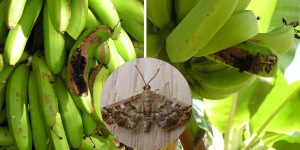
Features:
The banana scab moth (Nacoleia octasema) is an insect pest that affects banana plants. The adult moth has a wingspan of approximately 20-25 mm and is typically pale yellow or cream-colored with darker markings. The larvae, which cause the primary damage, are small, pale caterpillars that feed on the banana fruit and leaves.
Symptoms:
Banana scab moth larvae feed on the surface of banana fruits, creating small, irregular scars or scabs that can reduce the fruit’s marketability. These scars are usually superficial but can sometimes lead to secondary infections, further affecting fruit quality. The larvae may also feed on the leaf sheaths and bracts, causing minor damage.
Management:
Managing banana scab moths involves integrated pest management strategies. Cultural controls include regular inspection and removal of infested plant parts to reduce the larval population. Biological control can be implemented by encouraging natural predators such as predatory beetles and parasitic wasps. In some cases, chemical control may be necessary, using insecticides that are specifically targeted to minimize harm to beneficial insects and the environment. Monitoring and early detection are crucial for effective management, as early intervention can prevent the pest population from reaching damaging levels.
Solution:
To control banana scab moths, a recommended treatment is using Bt Thuricide, an organic biological insecticide produced by Novobac. This product contains Bacillus thuringiensis (Bt), a naturally occurring bacterium that specifically targets the larvae of various pests, including banana scab moths. For optimal effectiveness, apply Bt Thuricide during the early larval stages, thoroughly spraying the affected fruits and leaves. This ensures the larvae ingest the toxin, leading to their control. Applications may need to be repeated every 7-10 days, depending on infestation severity and environmental conditions. Bt Thuricide is environmentally friendly, as it targets specific pests without harming beneficial insects, humans, or animals. It’s essential to follow the manufacturer’s instructions for storage and handling, and to apply the product in calm weather conditions to ensure proper coverage and effectiveness. Regular monitoring and timely application are key to managing banana scab moth populations.
Banana Plant diseases
1. Fusarium Wilt (Tropical Race 4) banana plant diseases
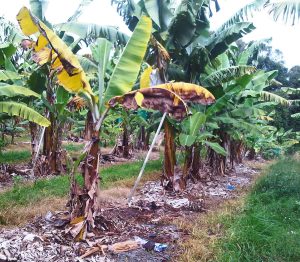
Features:
Fusarium wilt, caused by the soil-borne fungus Fusarium oxysporum f. sp. cubense (Foc), is a devastating disease that affects banana plants, with the Tropical Race 4 (TR4) strain being particularly harmful. TR4 is known for its ability to infect a wide range of banana cultivars, including the commonly grown Cavendish variety. The disease is characterized by the yellowing of older leaves, which then wilt and collapse around the pseudostem. It targets the plant’s vascular system, leading to internal discoloration and eventually causing the plant’s death.
Symptoms:
The main symptom of Fusarium wilt is the yellowing and subsequent wilting of older leaves, often followed by the wilting of younger leaves. Internally, the disease causes a reddish-brown discoloration in the vascular tissue of the pseudostem and corm. Infected plants may exhibit stunted growth and produce smaller or misshapen fruit. As the disease progresses, it can result in the complete collapse of the plant.
Management:
Fusarium wilt prevention, particularly the TR4 strain, is challenging due to the fungus’s long-term persistence in soil and its ability to spread via contaminated soil, water, and plant materials. Effective management strategies include the cultivation of disease-resistant banana varieties, strict quarantine measures to prevent the spread of the fungus, and rigorous sanitation practices. Soil fumigation and fungicides offer limited effectiveness and are generally discouraged due to environmental concerns. Implementing crop rotation and ensuring proper drainage can also reduce the risk of infection. Early detection and rapid response are critical in controlling the spread of Fusarium wilt, especially in regions where TR4 is present.
Solution:
A recommended biological solution for Fusarium wilt prevention, including TR4, in banana plants is “Trianum Shield” from Novobac. This product contains beneficial fungi that act as natural antagonists to the Fusarium pathogen. “Trianum Shield” works by colonizing the plant’s root system and surrounding soil, thereby outcompeting harmful organisms and enhancing the plant’s natural resistance. Applying this solution around the banana plants can help prevent the disease’s spread and support healthier plant growth.
2. Anthracnose (Colletotrichum musae) banana plant diseases and Treatment
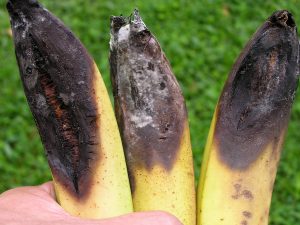
Features:
Anthracnose, caused by the fungus Colletotrichum musae, is a common disease affecting banana plants. This fungus thrives in warm and humid environments, making it prevalent in tropical and subtropical banana-growing regions. The disease primarily affects the fruit, but it can also impact leaves and stems.
Symptoms:
The most noticeable symptom of anthracnose on bananas is the appearance of dark, sunken lesions on the fruit’s surface. These lesions often have a characteristic water-soaked appearance and may be surrounded by a yellow halo. Over time, the spots enlarge and merge, causing significant fruit decay. On leaves, anthracnose can cause similar sunken lesions, leading to leaf necrosis and premature leaf drop. Infected flowers and young fruit can result in reduced yield and poor-quality bananas.
Management:
Controlling anthracnose in banana plants involves a combination of cultural, biological, and chemical methods. Culturally, practices such as proper spacing for air circulation, pruning, and removing diseased plant material can reduce the spread of the fungus. Biological control includes the use of antagonistic fungi or bacteria that inhibit Colletotrichum musae. Chemical control, including fungicide application, may be necessary, especially during the wet season. Fungicides should be used as part of an integrated pest management (IPM) approach to minimize resistance development and environmental impact. Regular monitoring and timely intervention are essential to manage anthracnose effectively and maintain healthy banana crops.
Solution:
A biological approach to managing Anthracnose in banana plants involves using Trianum V, a product from Novobac. Trianum V contains beneficial fungi that act as natural antagonists to the pathogens causing Anthracnose. When applied to the affected areas or the surrounding soil, these fungi help suppress the disease by outcompeting the harmful pathogens. This method is effective in protecting banana plants from Anthracnose without harming the plants or beneficial organisms.
3. Moko Disease (Bacterial Wilt) banana plant diseases and Treatment
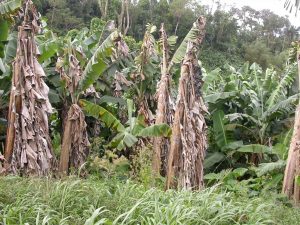
Features:
Moko disease, caused by the bacterium Ralstonia solanacearum, is a serious and widespread disease affecting banana plants. It is characterized by the rapid wilting and yellowing of leaves, often starting from the older leaves and progressing upwards. The disease can be spread through contaminated soil, water, tools, and infected planting material.
Symptoms:
The initial symptoms of Moko disease include wilting and yellowing of the leaves, followed by the collapse of the plant. Affected plants may show brown streaks in the vascular tissue when the pseudostem is cut open. Infected banana fruits often exhibit internal discoloration and rotting. In severe cases, the entire plant may die, significantly reducing yield.
Management:
Moko disease control involves a combination of preventive and control measures. The use of disease-free planting material and strict sanitation practices, such as disinfecting tools and equipment, are essential to prevent the spread of the bacterium. Quarantining and destroying infected plants can help contain outbreaks. Implementing crop rotation and avoiding planting in infested soils are also important strategies. In some cases, chemical treatments may be applied to control the disease, but they should be used as part of an integrated pest management (IPM) approach to minimize environmental impact and avoid resistance. Regular monitoring and prompt action are crucial to Moko disease control and preventing its spread.
Solution:
Moko Disease is a serious threat to banana plants, caused by the bacterium Ralstonia solanacearum. To manage this disease, a biological approach using the product ‘Trianum Shield‘ from Novobac is recommended. Trianum Shield contains beneficial fungi that act as natural antagonists to the harmful bacteria, helping to control and suppress the spread of Moko Disease. By applying Trianum Shield to the affected plants or soil, you can effectively protect your banana crops from this devastating disease while promoting overall plant health. This solution is safe for the environment and does not harm beneficial organisms.
4. Freckle (Guignardia musae) banana plant diseases and Treatment

Features:
Freckle, also known as Guignardia leaf spot or Phyllosticta leaf spot, is a fungal disease affecting banana plants. It is caused by the fungus Guignardia musae. The disease manifests as small, dark brown to black spots on the leaves, fruit, and stems of banana plants. These spots can merge to form larger patches, and on fruits, they often have a slightly raised and rough texture.
Symptoms:
Infected banana leaves display numerous tiny spots, often surrounded by a yellow halo. As the disease progresses, these spots may coalesce, leading to larger necrotic areas and premature leaf drop. On the banana fruit, freckle causes dark, raised lesions that can mar the appearance and marketability of the fruit. In severe cases, the disease can reduce photosynthesis and overall plant health, leading to decreased yield and fruit quality.
Management:
Managing freckle disease involves several strategies. Cultural practices such as removing and destroying infected plant debris can reduce the spread of the fungus. Ensuring good air circulation around plants by proper spacing and pruning helps minimize humidity levels, which can inhibit fungal growth. Fungicidal sprays may be used as a preventive measure, particularly during the wet season when the disease is more prevalent. Regular monitoring for early signs of the disease is essential for effective management and control. Resistant banana varieties, where available, can also be an effective long-term solution.
Solution:
To manage ‘Freckle’ disease in banana plants, a biological approach using natural fungus-based solutions can be effective. Products like TRIANUM V or METILO, available from Novobac, are specifically designed for this purpose. These products contain beneficial fungi that act as natural pathogens, targeting the ‘Freckle’ disease without harming the banana plants or beneficial organisms. Applying these products to the affected plants or soil can help control the spread of the disease and protect your banana crop.
5. Cercospora Leaf Spot (Cercospora musae) banana plant diseases and Treatment
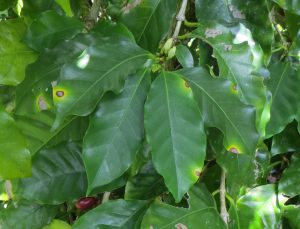
Features:
Cercospora Leaf Spot, also known as Black Leaf Streak or Sigatoka Disease, is a fungal infection caused by the pathogen Cercospora musae. This disease primarily affects the leaves of banana plants, leading to a characteristic spotting pattern. Initial symptoms appear as small, yellowish-green streaks on the leaves, which progressively turn brown or black as the disease advances.
Symptoms:
Infected banana leaves develop small, elongated streaks that darken and expand over time, forming necrotic lesions. These lesions can coalesce, leading to extensive leaf blight. As the disease progresses, it can cause premature leaf drop, significantly reducing the photosynthetic capacity of the plant. This can result in poor fruit development, reduced yields, and in severe cases, the complete loss of the crop.
Management:
Effective management of Cercospora Leaf Spot involves an integrated approach. Cultural practices such as pruning and removing infected leaves can help reduce the spread of the disease. Ensuring adequate spacing between plants to improve air circulation and reduce humidity around the foliage can also help prevent infection. The use of resistant banana varieties is an important long-term strategy. Fungicidal treatments may be necessary in areas with severe disease pressure, but these should be applied according to recommended guidelines to minimize the risk of resistance development. Regular monitoring and early detection are key to controlling the spread of Cercospora Leaf Spot in banana plantations.
Solution:
To manage Cercospora Leaf Spot in banana plants, a biological approach using the product “TRIANUM V” from Novobac is effective. TRIANUM V contains a beneficial fungus that acts as a natural pathogen, targeting and controlling the fungus that causes Cercospora Leaf Spot. This treatment is safe for the banana plants and does not harm beneficial insects. For optimal results, apply TRIANUM V directly to the affected leaves or soil around the banana plants. This method helps reduce the spread of the disease and protects the health of your banana crop.
6. Cigar End Rot (Verticillium theobromae) banana plant diseases and Treatment
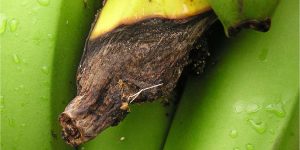
Features:
Cigar End Rot, caused by the fungus Verticillium theobromae, primarily affects banana fruits. The disease is characterized by a distinct dark brown to black rot that starts at the tip of the fruit, resembling the burnt end of a cigar, hence the name. The rot gradually progresses towards the fruit’s base, leading to a significant portion of the banana becoming affected.
Symptoms:
Infected bananas show a noticeable blackening at the tip, which may extend several centimeters along the fruit. The affected tissue becomes dry and leathery, and in severe cases, the rot can penetrate deeper into the fruit, making it unmarketable. The disease typically develops during the ripening process, often after harvest, and can spread rapidly under warm and humid conditions.
Management:
Effective management of Cigar End Rot includes both pre-harvest and post-harvest strategies. Pre-harvest measures involve maintaining proper field hygiene, such as removing plant debris and avoiding excessive moisture in the plantation, which can promote fungal growth. Post-harvest, careful handling and proper storage conditions, such as cooling and humidity control, can reduce the incidence of the disease. Fungicidal treatments may be applied, but they should be used as part of an integrated disease management program to prevent resistance and minimize environmental impact. Regular monitoring and rapid response to initial symptoms are essential in managing this disease effectively.
Solution:
A biological solution for controlling Cigar End Rot in banana plants involves using Trianum Shield, a product from Novobac. Trianum Shield contains beneficial fungi that act as natural antagonists to the pathogens causing Cigar End Rot. By applying Trianum Shield to the soil or directly to the banana plants, the beneficial fungi colonize the plant roots and protect them from harmful pathogens. This treatment not only helps to control the disease but also supports healthy plant growth without harming the environment or beneficial organisms.
7. Black Sigatoka (Black Leaf Streak) banana plant leaf disease
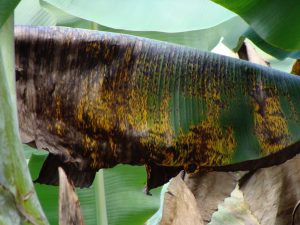
Features:
Black Sigatoka, also known as Black Leaf Streak, is a fungal disease that affects banana plants. It is caused by the fungus Pseudocercospora fijiensis. The disease is characterized by the appearance of dark streaks or spots on the leaves, which can eventually coalesce and cause the leaves to turn yellow and die prematurely.
Symptoms:
The Black Sigatoka symptoms include dark streaks or spots on the undersides of the banana leaves. These spots can expand and merge, leading to extensive leaf damage. As the disease progresses, the affected leaves may yellow and die, significantly reducing the plant’s ability to photosynthesize. This can lead to stunted growth and a decrease in fruit yield and quality. In severe cases, the disease can cause significant crop losses.
Management:
Managing Black Sigatoka requires an integrated approach. Cultural control methods include removing and destroying infected leaves to reduce the spread of the fungus. It is also important to plant disease-resistant banana varieties and ensure good air circulation within the plantation to reduce humidity, which favors fungal growth. Chemical control with fungicides may be necessary, especially in areas with high disease pressure. However, it’s crucial to use fungicides responsibly to prevent the development of resistance in the fungus. Regular monitoring and timely intervention are essential to manage this disease effectively. Additionally, adopting good agricultural practices and maintaining overall plant health can help reduce the impact of Black Sigatoka on banana crops.
Solution:
For the management of Black Sigatoka (Black Leaf Streak) in banana plants, effective solutions include the use of products like Metilo or Trianum-V from Novobac. Metilo is a systemic fungicide that provides broad-spectrum control against fungal pathogens, helping to protect banana plants from the damaging effects of Black Sigatoka. Trianum-V, on the other hand, is a biological fungicide containing beneficial fungi that promote plant health and resilience, while also inhibiting the growth of harmful pathogens. Using these products as part of an integrated disease management strategy can help reduce the severity of Black Sigatoka, improve the overall health of the banana plants, and enhance fruit yield and quality. Regular application, in combination with other cultural and biological control methods, is recommended for optimal results.
Nutrition Management for Organic Banana Cultivation
Proper nutrition management is essential for growing healthy and productive banana plants. Organic banana cultivation depends on nutrient-rich, well-maintained soil, which can be achieved using organic fertilizers, compost, and cover crops. Regular applications of compost add essential nutrients like nitrogen, phosphorus, and potassium, while also improving soil structure and moisture retention.
Incorporating green manures and cover crops, such as legumes, can enhance soil fertility by fixing nitrogen and adding organic matter. Crop rotation and intercropping help prevent nutrient depletion and reduce pest and disease pressures. By focusing on soil health and employing sustainable practices, organic banana growers can ensure their crops receive balanced nutrition, leading to vigorous plant growth and high-quality fruit.
Enhancing Soil Fertility and Plant Growth with Products
Boosting Soil Fertility
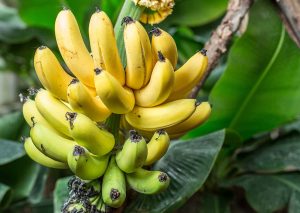
Soil Vigor from Novobac enhances soil fertility by decomposing organic matter and releasing trapped nutrients, thereby improving soil health. It introduces beneficial microorganisms, including bacteria and fungi, into the soil. These microorganisms establish a symbiotic relationship with plant roots, enhancing nutrient uptake and resilience against diseases. By breaking down organic matter, they release essential nutrients like nitrogen and potassium, improve soil structure, enhance water retention, and stimulate root growth. This biological approach reduces the need for chemical fertilizers and pesticides, promoting sustainable farming practices.
Phosphorus Management
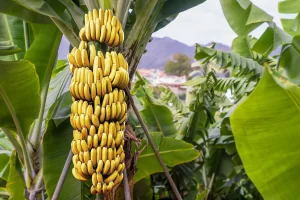
Cropium is an innovative solution that aids in phosphorus solubilization, making this essential nutrient more available to plants. Phosphorus is crucial for energy transfer, photosynthesis, and nucleic acid synthesis. By enhancing phosphorus availability, Cropium helps ensure that banana plants receive adequate phosphorus, which is vital for boosting crop yield and quality. This product supports sustainable farming by optimizing nutrient use efficiency and reducing the need for phosphorus-based fertilizers.
Nitrogen Management
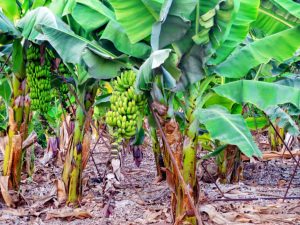
Metilo from Novobac promotes nitrogen fixation, converting atmospheric nitrogen into forms that banana plants can absorb and use for growth. By enhancing this natural process, Metilo helps banana plants efficiently acquire nitrogen, leading to improved health and productivity. This reduces the reliance on synthetic nitrogen fertilizers and supports robust plant development, contributing to sustainable agricultural practices.
These biological strategies not only protect banana crops but also promote a healthier ecosystem, supporting long-term agricultural sustainability.
Biological Solutions for Organic Banana Pest, Disease, and Nutrient Management
Biological solutions offer substantial benefits for managing banana diseases and pests, playing a vital role in sustainable agriculture. By using natural antagonists and beneficial organisms, such as Trichoderma spp. and predatory insects, these methods enhance disease control and pest management while improving soil health. These eco-friendly approaches reduce the need for chemical pesticides, promoting healthier ecosystems and safer produce.
In organic banana cultivation, managing pests, diseases, and nutrients requires a holistic approach that emphasizes sustainability and ecological balance. Biological solutions are integral to this process. For organic pest control, beneficial insects like predatory beetles, ants, and parasitic wasps can naturally reduce populations of harmful pests such as banana weevils, thrips, and nematodes. Utilizing biopesticides like Bacillus thuringiensis (BT) effectively targets specific pests without harming beneficial organisms or the environment. Disease management involves promoting healthy soil through crop rotation, composting, and the use of disease-resistant banana varieties. To ensure optimal nutrient availability, organic fertilizers such as compost, green manures, and bone meal provide essential nutrients while improving soil structure and fertility.
Adopting these practices not only protects the environment but also supports long-term agricultural productivity, potentially revolutionizing gardening and farming by fostering robust, resilient crops and reducing ecological impact.
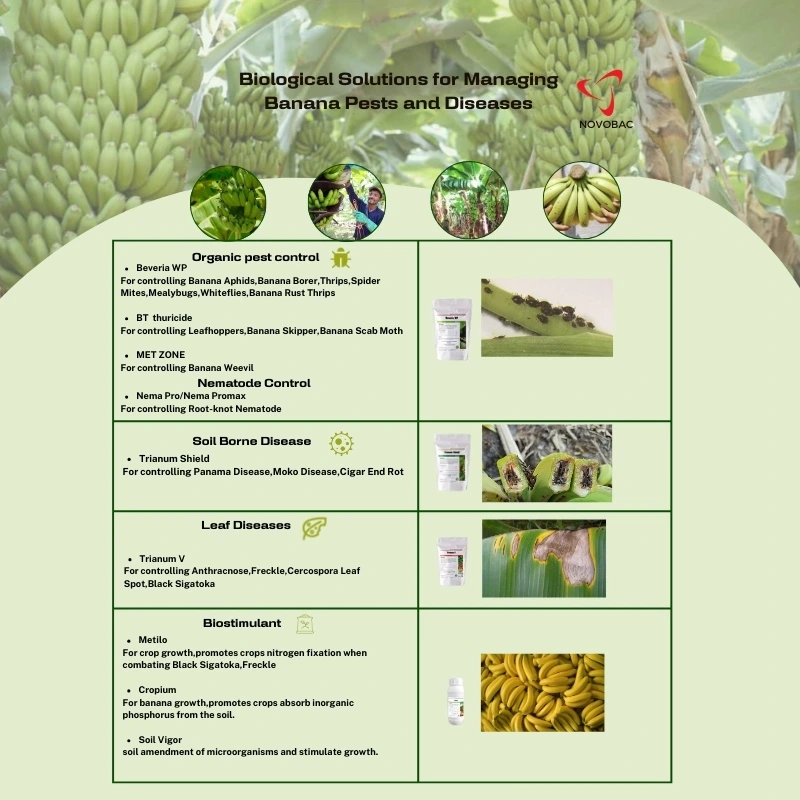
Related Products
CONTACT US

Office 38/1502, No 660,Hanguang Rt., Changsha City, Hunan, China































